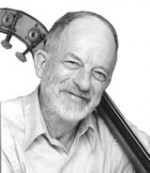Allegro
The Band Room
March '18
Volume 118, No. 3March, 2018

Bill Crow
www.billcrowbass.com
I met Teddy Wilson when I joined the Benny Goodman band in 1962 for a tour of the Soviet Union, with a warm-up week beforehand at the Seattle World’s Fair. During that first week, Benny decided he needed a more modern pianist. John Bunch had been helping him put the band together, and Benny prevailed on John to join us for the concerts in the Soviet Union. Teddy would play on the opening number that introduced the band, and then John would play the rest of the program. Drummer Mel Lewis and I prevailed on Benny to feature Teddy on some trio numbers, and so we became the Teddy Wilson Trio for the rest of that tour.
After we had been in Russia for several weeks, Teddy called me to his hotel room one afternoon and handed me an electric hair clipper. “I want you to give me a haircut,” he said. I was pleased that he was willing to trust me, and found that it was not a difficult task. I did so well that several of the other musicians who stopped by Teddy’s room that afternoon had me provide the same service for them. I got a lot of compliments for my work, but no tips.
A few years after that tour I was playing with the Walter Norris Trio at the New York Playboy Club, when the management decided to put our group in one of the showrooms in the club, and hired Teddy’s trio for the room we had been playing in. I was glad to get the chance to hang out with Teddy again, usually at the bar or in the entertainer’s dressing room on the sixth floor. We amused the other musicians with reminiscences of the tour with Benny’s band.
After that gig ended, I was home one evening in our house in Rockland County when the phone rang. It was a record producer in a great panic, asking how long it would take me to get out to the recording studio in Bayside Long Island. They were doing a record date with Teddy and strings, and they had just fired the bass player. I told him it would take me an hour to get there, and the guy said Teddy wanted me, and that they would wait for me. So I jumped in my car with my bass and headed for Bayside. When I got there, the guy I had talked to on the phone ran over and said, “Now, just play the way you played for Teddy when you were with his trio. Don’t pay any attention to the parts.”
Teddy smiled over at me from the piano, and I set up with the rhythm section. We played mostly ballads, and the bass parts were mostly half notes. I took a few liberties with them, but pretty much played what was written. Nobody explained what had happened with the other bass player, but everyone seemed happy. When we were through I signed the form to get paid and went home, and that was the last time I saw Teddy Wilson.
![]() Rob Ronzello told me that he used to visit arranger Bill Finegan at his home in Monroe, Connecticut. Bill was one of Glenn Miller’s arrangers during his most popular years. Rob would sometimes bring tapes of Miller tunes, mostly from airchecks that had no arranger credit, hoping Bill could set the record straight.
Rob Ronzello told me that he used to visit arranger Bill Finegan at his home in Monroe, Connecticut. Bill was one of Glenn Miller’s arrangers during his most popular years. Rob would sometimes bring tapes of Miller tunes, mostly from airchecks that had no arranger credit, hoping Bill could set the record straight.
One day Rob brought “In The Middle Of A Dream” from 1939. Finegan, then age 84, using a walker to get to his piano, played a modulation in the arrangement from memory. He hadn’t heard it in all those years.
![]() Here are a few stories from Bill Wurtzel.
Here are a few stories from Bill Wurtzel.
Bill knew the former New York police commissioner Ray Kelly, who was a fan of Bill Doggett. When he heard that Wurtzel was playing with Doggett at Showmans Jazz Club in Harlem, Kelly came in with an entourage of policemen. Wurtzel said it looked like a raid.
Wurtzel and Howard Morgen were once visited at a gig by a friend, who lay down on the floor by the bandstand to demonstrate some new yoga moves to them. So they got to see Paul Simon from a new perspective.
Wurtzel also told me about his friendship with the late Mundell Lowe. “He was not only the first jazz guitarist I listened to, he was a dear friend who I miss. Mundy gave me this nugget: ‘Don’t melodize the harmony, harmonize the melody!’”
![]() I was looking at my copies of some of my earliest Bandroom columns, and thought I would revisit a few items. Here’s one from October 1984:
I was looking at my copies of some of my earliest Bandroom columns, and thought I would revisit a few items. Here’s one from October 1984:
Before recording studios began providing amplifiers for guitar players, the musicians had to carry their own amps from date to date. In the 1950s a bunch of New York guitarists started the Guitar Club, which placed locked amps in every New York recording studio, with a key for each member.
One day Don Arnone was finishing up a date at Fine Sound, and discovered that Andres Segovia was recording in the other studio. He asked the studio manager if he could slip in and listen.
“Oh, no,” said the manager. “Nobody gets in there. Orders from Segovia.”
“Okay,” said Don. “Tell him he can’t use any of our amps!”
